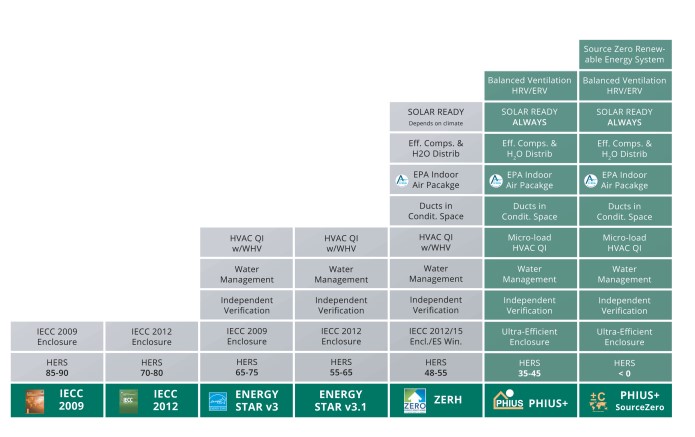LEED and Living Buildings are holistic rating systems. There are a number or energy-only rating systems in the U.S. The following is a sampling of a few of them.
Benchmarking and Energy Use Index
Energy Use Index (EUI) and Benchmarking are very common metrics in the energy management industry and energy policy world. They focus solely on energy use, and are relatively simple ways to assess and influence the energy efficiency of buildings.
To Read/Watch Now
First, read the following short reading about Energy Use Index (sometimes called "Energy Use Intensity") and watch the video below.
- Energy Use Intensity, EPA EnergyStar
Benchmarking is a common practice in the commercial energy efficiency industry. The most commonly used software for this is Portfolio Manager from the U.S. Environmental Protection Agency (EPA). Read the summary of both of these below
- Portfolio Manager, U.S. EPA
An energy use index (EUI) is relatively easy to determine. You just take a year's worth of energy bills, convert the total energy use to kBTU (thousands of BTUs), then divide by square footage. That's it! This gives you a snapshot of the general energy efficiency of a building, though not a comprehensive one. It is a helpful basis of comparison for other buildings, which is exactly what EPA Portfolio Manager does. Portfolio Manager compares your building's EUI with other similar buildings. What is meant by "similar?" Well, that depends on a few factors, but the most important aspects are 1) buildings in a similar climate zone and 2) buildings that are used for similar things. For example, the mean EUI of an education building in the U.S. is 51 kBTU/ft2, while the mean EUI of a hospital is about 188 kBTU/ft2 (source: Lawrence Berkley National Laboratory Buildings Performance Database). Why the difference? Think about the difference in operating hours and equipment used in these buildings. Given this, it would be unfair to compare the "typical" energy use of a hospital with the "typcial" energy use of a college or middle school. Similarly, you would expect slightly different energy use based on the climate. The exact same building in a temperate climate such as, say, Coastal North Carolina would use less energy than one in a cold climate such as Minnesota or Maine or a hot, humid climate such as Florida.
EPA provides you with an "Energy Score" based on other buildings in their database. A score of 25 means you have a lower EUI than 25% of comparable buildings, a score of 50 means you have a lower EUI than 50% and higher than 50%; a 90 means you have a lower EUI than 90% of buildilngs, and so on. EPA provides the option of being Energy Star rated if you have a score of 75 or above. Some municipalities (such as Philadelphia) require buildings to obtain their Energy Score every year so that they may constantly see how they compare to other buildings. The benefit of doing this every year is that you are forced to keep up with your peer buililngs. Let's say you get a score of 75, then think: "Cool, I'm very efficient. I don't need to make any upgrades." But then if other buildings become more efficient over time, your score will drop. In this way, the process of improving efficiency in theory never ends.
Energy Star Buildings
Energy Star is a program created and run by the U.S. Environmental Protection Agency (EPA). As the name implies, this is an energy efficiency rating system that has the following four components:
-
a high efficiency thermal enclosure system (thermal envelope!)
- high efficiency heating and cooling
- proper water management to protect building components from water damage
- energy efficient lighting and appliances
To Read/Watch Now
According to the EPA, Energy Star certified homes "are at least 10% more efficient than homes built to code and achieve a 20% improvement on average." Please read the following summary of the Energy Star Residential New Construction Program:
Here is a great video that introduces some of the benefits of Energy Star Homes. It is geared towards builders but is a helpful introduction for anyone.
OPTIONAL
- Take a look at specific Energy Star Certification requirements, which are slightly different depending on the climate zone the building is in.
- View the Energy Star Certification requirements for Philadelphia buildings.
Passive House Certification
Passive House Certification is effectively a more robust version of Energy Star Certification. There are actually two different certifying bodies in the U.S. - Passive House Institute (PHI) and Passive House Institute U.S. (PHIUS) - as detailed by ecohome here. The distinction is not important for our purposes, but we will focus on PHIUS standards. The image below provides a sense of how robust Passive House standards are relative to Energy Star and other standards. See this document for a fuller explanation.

To Read Now
Please read the overview below and click on the second link to look at some of the differences between PHIUS and other energy efficiency standards:
The following is a summary of the energy-only rating systems:
Benchmarking:
- EUI = energy use/ft2/yr
- General indicator of energy efficiency
- Must consider climate and use
- Easy to do – just requires utility bills and size, and a comparison to other buildings.
- Benchmarking overseen by the U.S. EPA via Portfolio Manager
Energy Star Certification
- Overseen by the U.S. EPA
- Energy Star Homes must meet specific efficiency standards and address insulation, air tightness, appliances, efficient heating and cooling, and more
- Average energy use reduction 20%
Passive House Certification
- Most robust energy standard
- Includes everything that Energy Star does, plus more.
- Can reduce energy use up to 60% - 70%